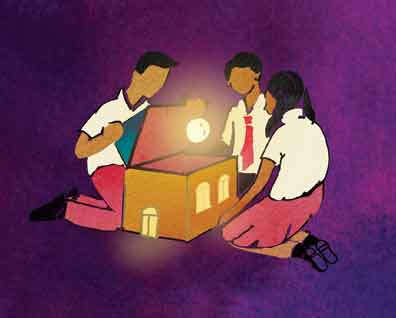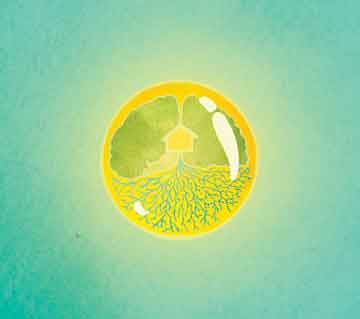Sheela Ramakrishnan
The editorial team at Teacher Plus and I had several discussions on what approach this piece should have. The team suggested “futuristic”. To me the word “futuristic” brought visions of sci-fi movies and robots. What would they do in a subject like home science? I said that I had taken home science in school when I did Senior Cambridge. It was an optional subject and the final grades were on the best of 5. It was this conversation that sowed the seed of my thoughts to follow.
I reflected on my life as an educator for about four decades, and that of a home maker for an almost equal time. And that of the home in which I lived and of the several other homes that I knew of among family and friends. Each was unique and yet the same in many ways. It required people (whatever be the relationship) to come together to build a home. Today that could be a group of friends shacking together in a strange city to eke out a living, or a single person living on his/her own or a family composed in a variety of ways. The commonality is that home means comfort. Inner and outer. To be either shared or experienced alone. It is one’s safe haven.

And these homes are the building blocks of the fabric of our communities, the larger society or the entire world. Each home is a microcosm of values, beliefs, lifestyle, attitudes that collectively shape our lives in hundreds of ways each day. Examined in this context, the study of home science as a subject has tremendous potential, largely untapped. Each of us are what we are, primarily because of our homes and then because of our environment, which is nothing but the influence from other homes.
The angle of my submission here would be clearer by the following three points.
a) The broad and relevant scope of home science
The study of home science, or the science of a home if I were to flip the name, takes on a significance unmatched by any other subject! School is the second home for all students. It is where they spend the maximum time in the first 15 years of their schooling years. The holistic wellbeing of every human is critically dependent on the nourishment to the body and mind that he receives at his place of learning and development which are home and school.
It is at home that the child learns his first lessons of life, externally and internally. Cleanliness, hygiene, food production, housekeeping, security, sharing, cooperation, responsibility. The same is extended at the school level, where he takes his place as a member of society. Yet this subject, which contains in its curriculum all the core elements of healthy living, has been given a status that leaves much to be desired. More about it later.
b) The thrust of the NEP
Now let us examine the NEP. The main submission of the latest policy is the blurring of boundaries between subjects and the strong emphasis on practical application and learning. It recommends internships beginning from the middle grades itself. I give below the references in the NEP that will build better clarity to my analysis and argument. (Page references are from the pdf document available online)
Page 6: Principles/Holistic/Flexibility/Multidisciplinary/Critical Thinking/Ethics
Page 13: focus on skills/Experiential learning
Page 14: Blurring of boundaries between subjects and streams
Page 16: Curricular integration
Page 17: Internships/Ethics
The NEP makes a strong case for the integrated or the multidisciplinary approach in dealing with school subjects. We can no longer afford to teach subjects in silos. It is easy to hone in the interrelatedness between subjects by using a fulcrum or hook that emanates from daily life. The home science curriculum offers many such opportunities that can reveal the permeation of different subjects into each other in an extremely effective and practical way. How can this thinking suddenly happen in high school, which is where this subject is introduced?
An additional reference is the initiative taken up by the Oxford University Press global initiative in promoting SHAPE (Social Studies, Humanities, and the Arts for People and the Economy) – for underscoring the importance of these subjects in the overall development of our students and therefore the world. https://global.oup.com/academic/news/shape?cc=in&lang=en&#:~:text=Oxford%20University%20Press%20(OUP)%20is,play%20in%20our%20everyday%20lives.
The coming months and years will see OUP’s convinced efforts to promote the intersection of SHAPE and STEM, through webinars, workshops, discussions and articles, so that the message reaches the last mile. It is a work for the long haul. The recognition of the need for the left and right brains of our educational system to be developed holistically for the welfare of man and the world in which he lives, couldn’t have been realized more sharply than in 2020. The pandemic taught us lessons of life, for life, lessons for our planet. It also taught us that it all begins from home.
c) Status of home science currently
It is a subject that is reluctantly retained by some schools for students in grades 9 to 12. The state boards are very varied and most do not offer it. The next step is the several home science colleges that churn out graduates.
The schools offer it as an optional subject – the lesser cousin to those who cannot deal with, say math or the elevated science subjects. In that is built in the second-class citizen status. The other factor is the gender bias (more about that in another article here, so I will just dwell upon it briefly).
In a world where home making has evolved into a partnership between man and woman, to treat the study of this subject as that meant only for girls, seems archaic and regressive. A close look at the gender divide in those taking this subject in schools and colleges will reveal this. There are various career options that are open either for entrepreneurship or employment. Food production, tourism and service, healthcare, diet and nutrition, teaching, textiles, resource management – are all industries where the human element is very strong and cannot be replaced by technology. How is this only for girls or only for some people?

a) Potential of the subject
The subject needs to be viewed with fresh eyes in the light of mechanization of several chores in the home – machines to wash clothes, machines to wash dishes, smart chemicals to remove stains, child care being relegated to day care centres, housekeeping at home with robots, economics no longer a male domain, banking, child rearing being more complex – the curriculum cries to be revamped and made relevant to the changing times.
If the curriculum is re-looked and made more contemporary, it offers the ideal base for EVERY subject in the curriculum to be linked towards a multidisciplinary approach. It offers direct opportunities for internships in several of the arenas mentioned above. Then isn’t it only logical that the subject be treated on par with others? The flexibility of this subject to form the intersection between SHAPE and STEM is not difficult to see. Should not the subject then be introduced early on and developed gradually? Should we not follow the same spiral that is followed for other subjects here too, from primary through middle and high school into college?
This is the only way we can usher in a genderless cohesiveness in society. It is of utmost importance that values necessary for such a cohesive fabric be inculcated early – in terms of importance as well as in terms of genderlessness.
b) Way forward for the subject
In the light of all the above, I hereby make a submission for repositioning this subject from its present place.
• Let us re-examine the curriculum for scope and relevance, given the new order of the world and the social dynamics that the planet needs ahead. The past is over. We now live in and will live in a completely changed world. There is no going back. The curriculum needs to reflect this changed social order, dynamics and lifestyle.
• Let us begin the study of understanding how to run a home early on, from the primary like all other subjects. Home making, both the physical running as well as the social and emotional adjustments required, is not something that one learns overnight or in a few years. It is easy to see all around us, how many just don’t get it!
• Above all, let’s push for a social order that places equal responsibility on man and woman in home managing. Unless we look at it from all angles, this change that the world needs so badly, will not get effected. Neither man nor woman is either inferior or superior – we are partners. Using each other’s strengths to make a better world while accepting and respecting our limitations.
To expect an entire society to move in this direction on their own is a pipe dream. Everyone needs a nudge. Our educational system can provide that. By sending a strong signal.
• Should we not revisit the curriculum relevant in the light of the new world?
• Should we not make home science a compulsory subject?
• Should we not take strong steps to remove gender bias in the basic unit of the home?
These are the three questions that I would like us all to ponder on.
The author is an Advisor to schools in school transformation, curriculum development and classroom methodology. She is the co-author of four series of textbooks published by the OUP, a certified ISO 21001 auditor, a counsellor and trained e-coach for students with anxiety from the Stanford School of Medicine and trained in Creative Thinking in the UK and Activity Based methods of teaching in Malaysia and Thailand. She can be reached at sheela.ramakrishnan@gmail.com.
